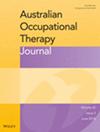Exploring occupational therapy practice in Australian residential aged care facilities: A cross-sectional survey
Abstract
Introduction
Occupational therapy in residential aged care facilities (RACFs) can enhance residents' occupational engagement and wellbeing. However, industry reports suggest that occupational therapists in Australian RACFs have mostly provided physical therapies such as pain management via massage and not addressed residents' occupations. There is limited literature on what constitutes occupational therapists' practice in RACFs to inform policy and practice. The aim of this cross-sectional survey was to explore practice patterns of occupational therapists working in Australian RACFs and influences on their practice.
Methods
Occupational therapists working in Australian RACFs were invited from July 2019 to March 2020 to complete a self-report online questionnaire via email and advertisements on industry websites, newsletters, and social media. The questionnaire asked therapists about their caseload, referrals, assessments, and interventions. Data were analysed descriptively and presented as frequencies and percentages.
Results
A total of 214 occupational therapists completed the survey. Occupational therapists' daily practice largely focussed on pain management; other areas of practice included falls prevention, pressure care, and mobility. The Aged Care Funding Instrument in place at the time of the survey was identified as the leading factor influencing therapists' choice of assessments and interventions. Organisational policies and procedures were also perceived as key factors influencing occupational therapy practice.
Conclusion
This paper highlights the influence of government funding and organisational policies in limiting occupational therapists' scope of practice and their ability to fully address the occupational needs of residents. Occupational therapists and the profession in general should be aware of factors in aged care funding models, and their application, that restrict occupational therapy practice and inhibit residents' function and advocate for change where needed. With the introduction of the Australian National Aged Care Classification funding model replacing Aged Care Funding Instrument, future research should explore potential changes to therapists practice following the implementation of the new funding model.

 求助内容:
求助内容: 应助结果提醒方式:
应助结果提醒方式:


